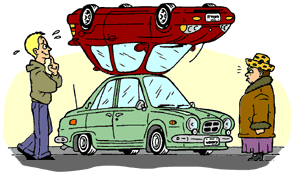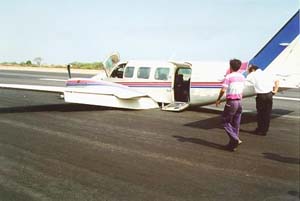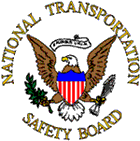 Being involved in a car fender-bender is usually a simple proposition to contend with.  Exchange information with the other driver, maybe file a police report, call for a tow if needed, and then notify your insurance company.  All pretty basic stuff.  Not surprisingly, things are a little different when you are involved in an aircraft accident, as there are greater opportunities to make a bad situation worse.  Your greatest resource in this situation will be your aviation insurance company who can provide the necessary guidance on how to best proceed, but there may be circumstances when you will not be able to contact them right away.  The NTSB controls serious accidents, which involve injuries or fatalities, so for purposes of this discussion, let’s focus on accidents that do not involve injury situations and where you as the pilot may be called upon to make some decisions.
Being involved in a car fender-bender is usually a simple proposition to contend with.  Exchange information with the other driver, maybe file a police report, call for a tow if needed, and then notify your insurance company.  All pretty basic stuff.  Not surprisingly, things are a little different when you are involved in an aircraft accident, as there are greater opportunities to make a bad situation worse.  Your greatest resource in this situation will be your aviation insurance company who can provide the necessary guidance on how to best proceed, but there may be circumstances when you will not be able to contact them right away.  The NTSB controls serious accidents, which involve injuries or fatalities, so for purposes of this discussion, let’s focus on accidents that do not involve injury situations and where you as the pilot may be called upon to make some decisions.
 If an accident occurs on an active runway, there will be a lot of pressure put on the pilot to have the plane moved as soon as possible so that the airport can re-open.  The trick here is to find someone who can competently move the plane without causing further damage.  Do not let anyone touch the aircraft that is not professionally involved in aviation maintenance or aircraft recovery.  I have been involved in situations where well-meaning non-aviation recovery services or individuals have attempted to improperly move or lift an aircraft and end up causing greater damage than the initial accident did by bending wings, dropping the plane, or causing the landing gear to collapse.  If you can’t get in touch with your insurance company, there will usually be an FBO or airport manager on the field who may provide some guidance in finding a retrieval outfit.  You should also try to get in touch with your regular mechanic as he may have expertise in your particular aircraft and can advise on the proper way to move or lift it.  It is also not a bad idea to take some photos of the aircraft before it is moved to document the accident scene and damage.
If an accident occurs on an active runway, there will be a lot of pressure put on the pilot to have the plane moved as soon as possible so that the airport can re-open.  The trick here is to find someone who can competently move the plane without causing further damage.  Do not let anyone touch the aircraft that is not professionally involved in aviation maintenance or aircraft recovery.  I have been involved in situations where well-meaning non-aviation recovery services or individuals have attempted to improperly move or lift an aircraft and end up causing greater damage than the initial accident did by bending wings, dropping the plane, or causing the landing gear to collapse.  If you can’t get in touch with your insurance company, there will usually be an FBO or airport manager on the field who may provide some guidance in finding a retrieval outfit.  You should also try to get in touch with your regular mechanic as he may have expertise in your particular aircraft and can advise on the proper way to move or lift it.  It is also not a bad idea to take some photos of the aircraft before it is moved to document the accident scene and damage.
 Once the plane is retrieved, try to find a secure and private spot for it, as damaged aircraft tend to become tourist attractions.  If you have expensive avionics and can’t get the plane in a hangar, most insurance companies will reimburse the cost to have the radios removed for safekeeping.  If an accident occurs off the airport (and many of them do), it may take a few days to have the airplane retrieved and this is best coordinated with the insurance company who will have access to a number of capable retrieval companies with the proper equipment.  Again, make arrangements to have valuable components protected and, if need be, retain security services or local law enforcement to watch the plane.  The insurance company will reimburse any reasonable protective costs and keep in mind that you are obligated under your insurance policy to take reasonable steps to prevent any further damage or loss to your aircraft after an accident.  If you don’t, the additional post-accident loss may not be covered.  Also, if the accident causes damage to someone else’s property don’t make any comment with regard to who is going to pay for what or otherwise admit liability.  Liability and damages will be determined in the course of the investigation and will be addressed by your insurance carrier.
Once the plane is retrieved, try to find a secure and private spot for it, as damaged aircraft tend to become tourist attractions.  If you have expensive avionics and can’t get the plane in a hangar, most insurance companies will reimburse the cost to have the radios removed for safekeeping.  If an accident occurs off the airport (and many of them do), it may take a few days to have the airplane retrieved and this is best coordinated with the insurance company who will have access to a number of capable retrieval companies with the proper equipment.  Again, make arrangements to have valuable components protected and, if need be, retain security services or local law enforcement to watch the plane.  The insurance company will reimburse any reasonable protective costs and keep in mind that you are obligated under your insurance policy to take reasonable steps to prevent any further damage or loss to your aircraft after an accident.  If you don’t, the additional post-accident loss may not be covered.  Also, if the accident causes damage to someone else’s property don’t make any comment with regard to who is going to pay for what or otherwise admit liability.  Liability and damages will be determined in the course of the investigation and will be addressed by your insurance carrier.
What if you have an accident resulting in what appears to be only minor damage such as a dented wing or buckled firewall? The temptation to fly it back to home base will be great, but there may be safety-of-flight issues that are not readily apparent to the untrained eye.  I have had pilots make such flights unaware that the prop was bent or that the airframe had internal damage.  Also, a damaged aircraft is no longer legally airworthy.  An aircraft involved in an accident should only be flown after a certified mechanic has inspected the damage, made any necessary field repairs, and has obtained a ferry permit from the FAA if required.  If a ferry flight is not permitted, the aircraft will either have to be repaired where it is or disassembled and trucked to another repair location.  All this may take more time, but it is the legal and safe way to proceed.
 Often pilots reporting an accident or claim will ask me whether they need to notify the FAA or NTSB.  I will usually refer the pilot to Part 830 of the NTSB regulations that discuss mandatory aircraft accident reporting requirements.  In brief, reporting is required for occurrences involving “death, serious injury, or substantial damage to the aircraft.”  “Serious injury” and “substantial damage” are defined in this regulation along with additional reporting requirements for certain aircraft system failures, in-flight fires, and mid-air collisions.  You can find Part 830 in the supplement section to most FAR booklets.  Keep in mind that even when there is no reporting requirement, the FAA may initiate an investigation anyway to determine if an enforcement action is warranted.  That is a whole separate topic in itself.
Often pilots reporting an accident or claim will ask me whether they need to notify the FAA or NTSB.  I will usually refer the pilot to Part 830 of the NTSB regulations that discuss mandatory aircraft accident reporting requirements.  In brief, reporting is required for occurrences involving “death, serious injury, or substantial damage to the aircraft.”  “Serious injury” and “substantial damage” are defined in this regulation along with additional reporting requirements for certain aircraft system failures, in-flight fires, and mid-air collisions.  You can find Part 830 in the supplement section to most FAR booklets.  Keep in mind that even when there is no reporting requirement, the FAA may initiate an investigation anyway to determine if an enforcement action is warranted.  That is a whole separate topic in itself.
After the initial excitement settles down, your aviation insurance company will work with you to get things back on track and get your airplane mended.  No one wants to have an accident, but it would be pretty cavalier to think that it could never happen to you.  The reality is that non-injury aircraft accidents occur every day and even the most seasoned pilots find that they are now venturing in to unfamiliar territory with regard to what needs to be done after a mishap.  A little preparation here is a good thing and hopefully you will never need to use it.
Editor’s Note: This article was written by Ken Steiner prior to his retirement from the United States Aircraft Insurance Group as a Vice-President and Claims Manager. During his career, Ken investigated thousands of aircraft accidents involving small planes, crop dusters, helicopters, corporate aircraft, and airliners. He has been on-site at over 100 fatal aircraft accident investigations. He is currently an Aviation Investigative Consultant and is also a Pilot and Tactical Flight Officer for the San Mateo County Sheriff’s Air Support Unit. He owns a Cessna 182 based at San Carlos and holds ATP and CFI certificates with over 5000 flying hours.



